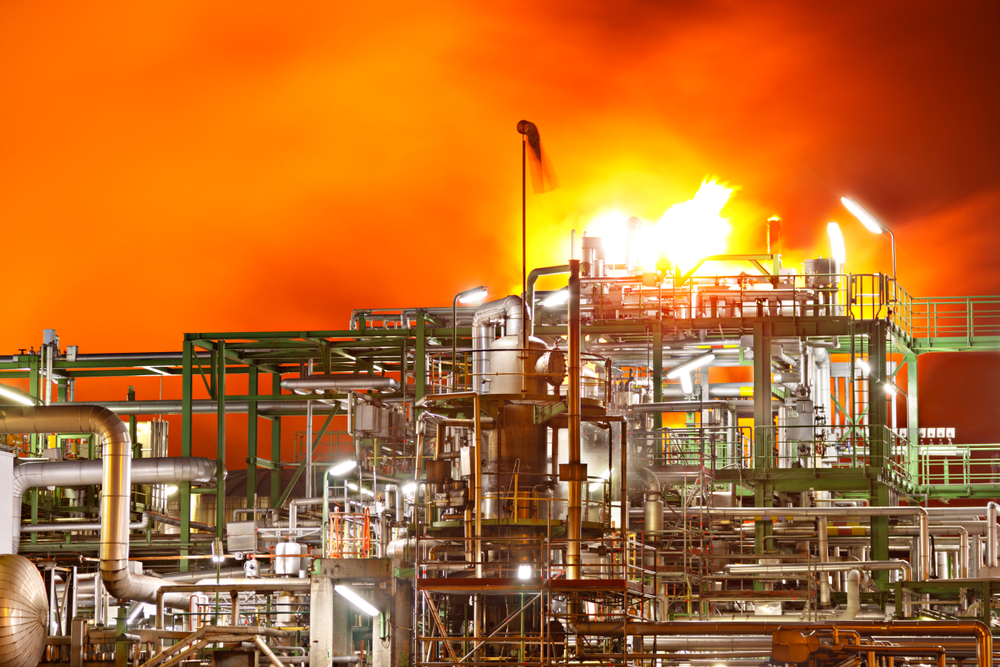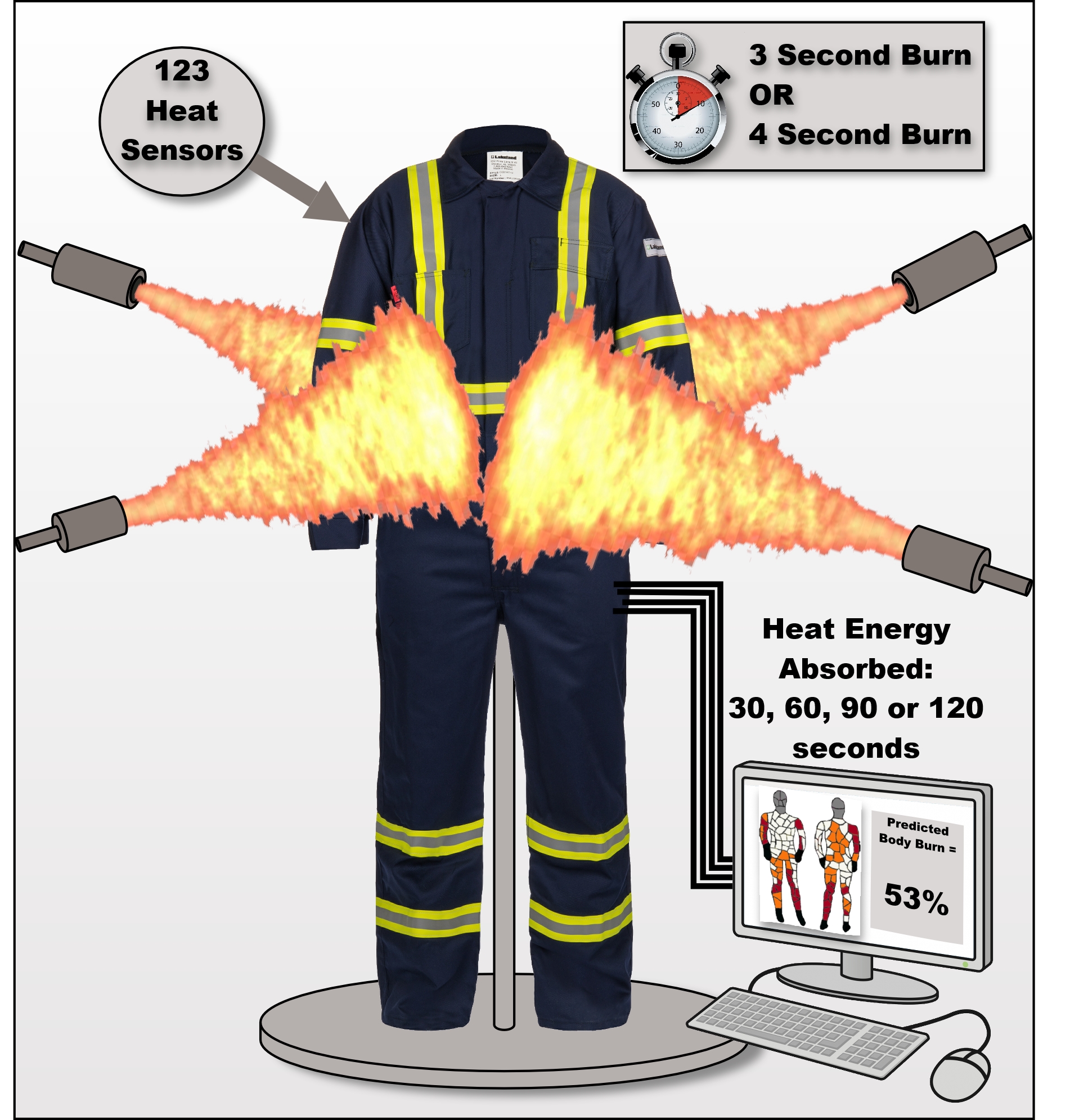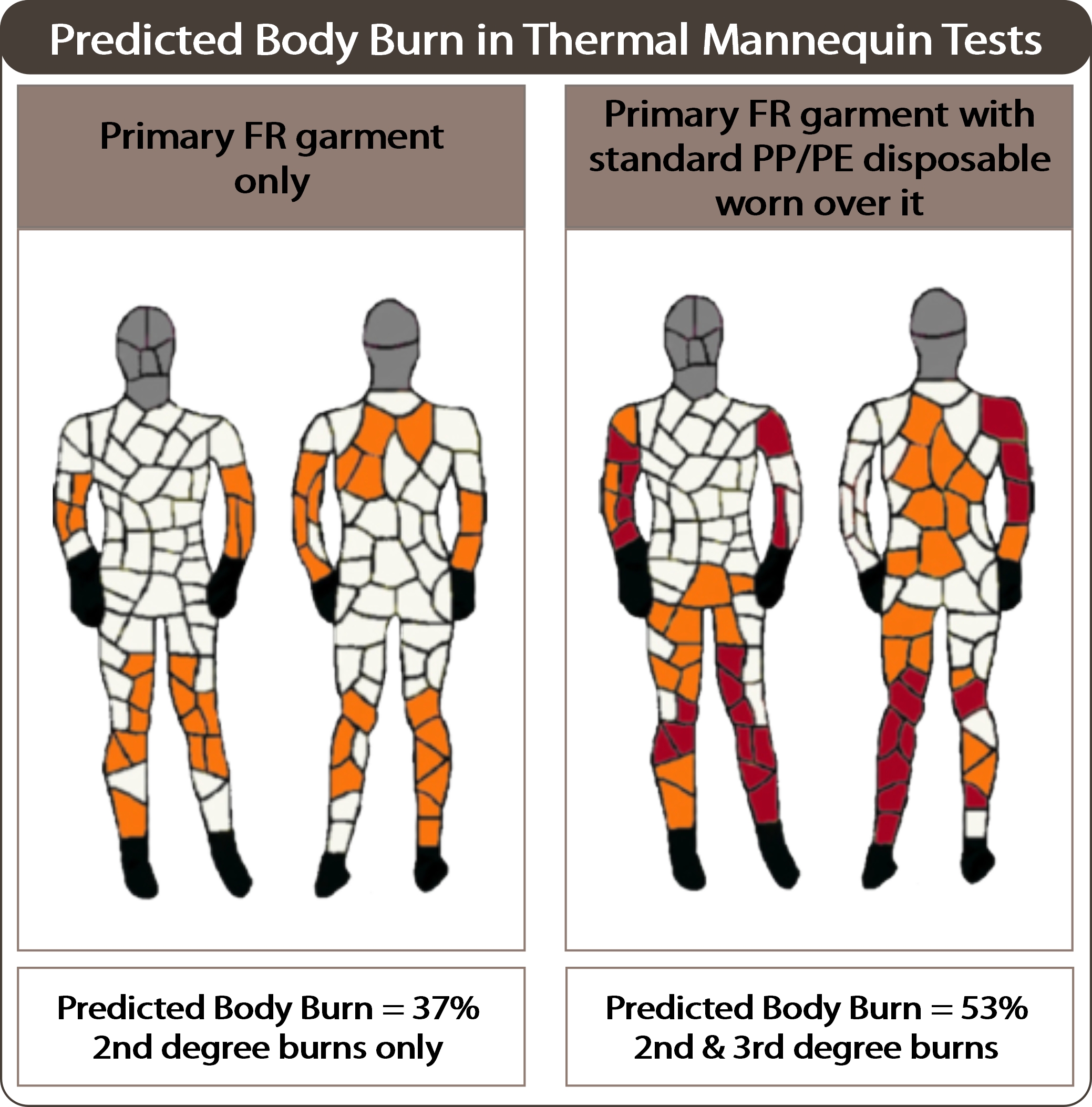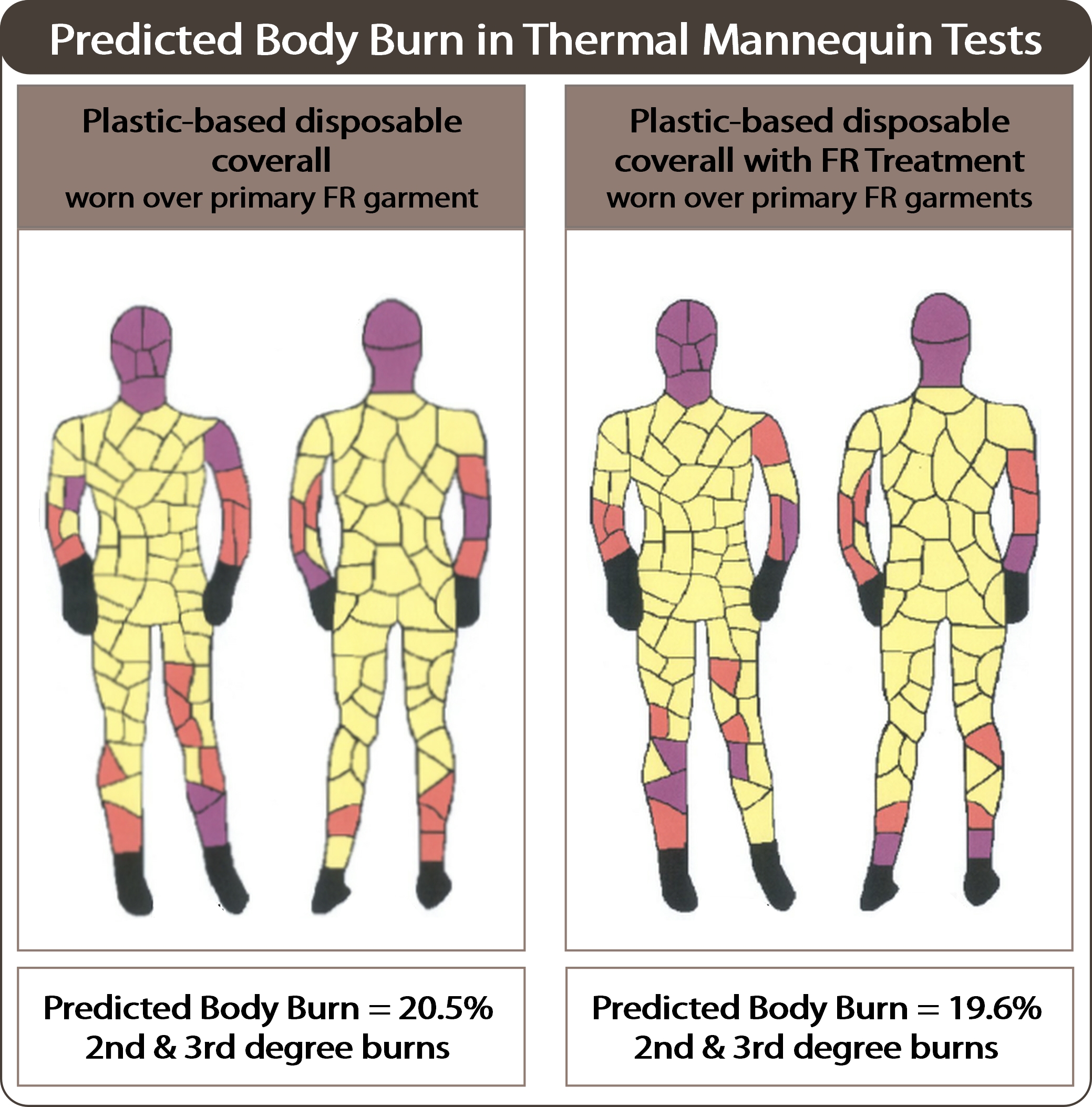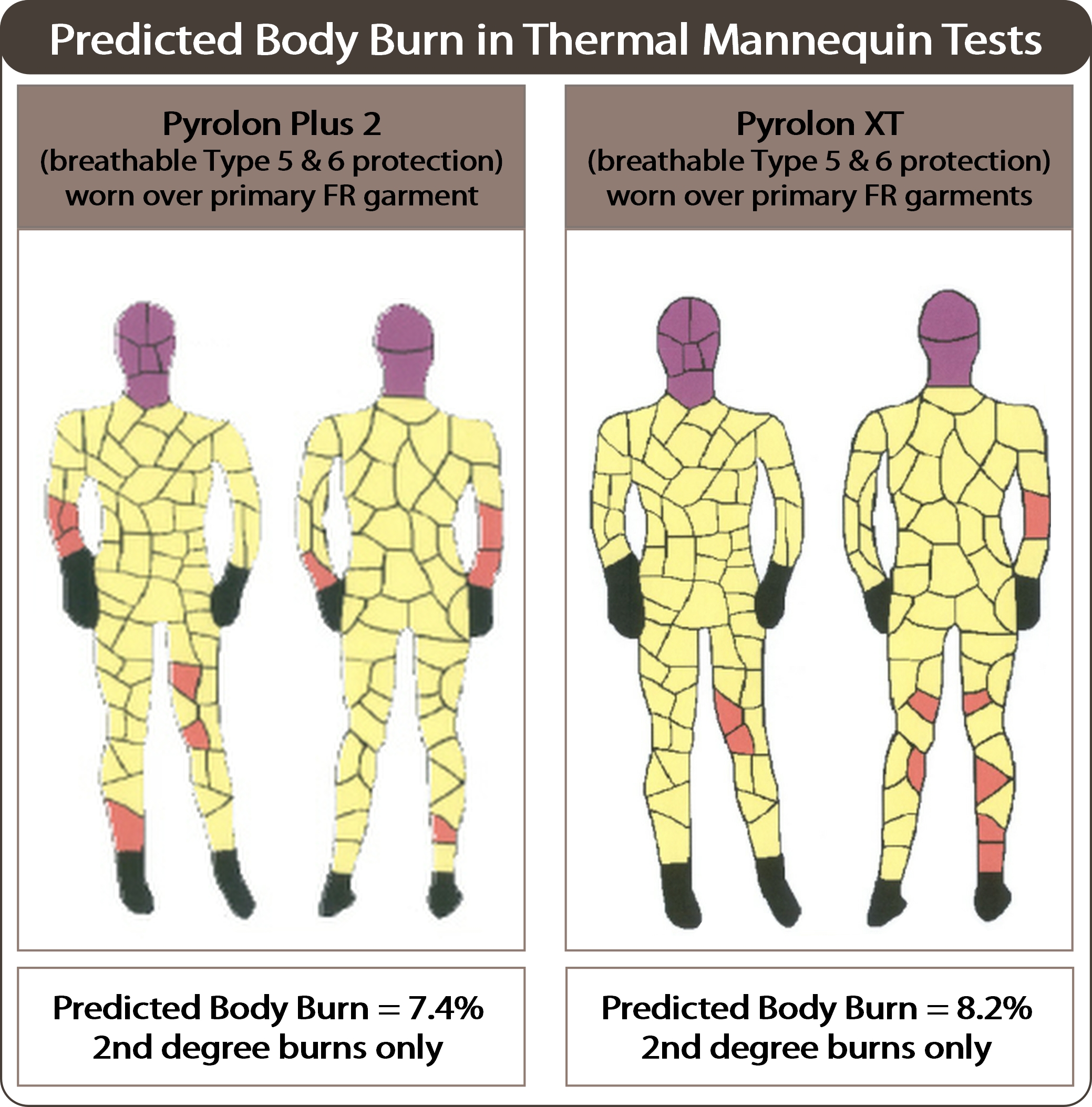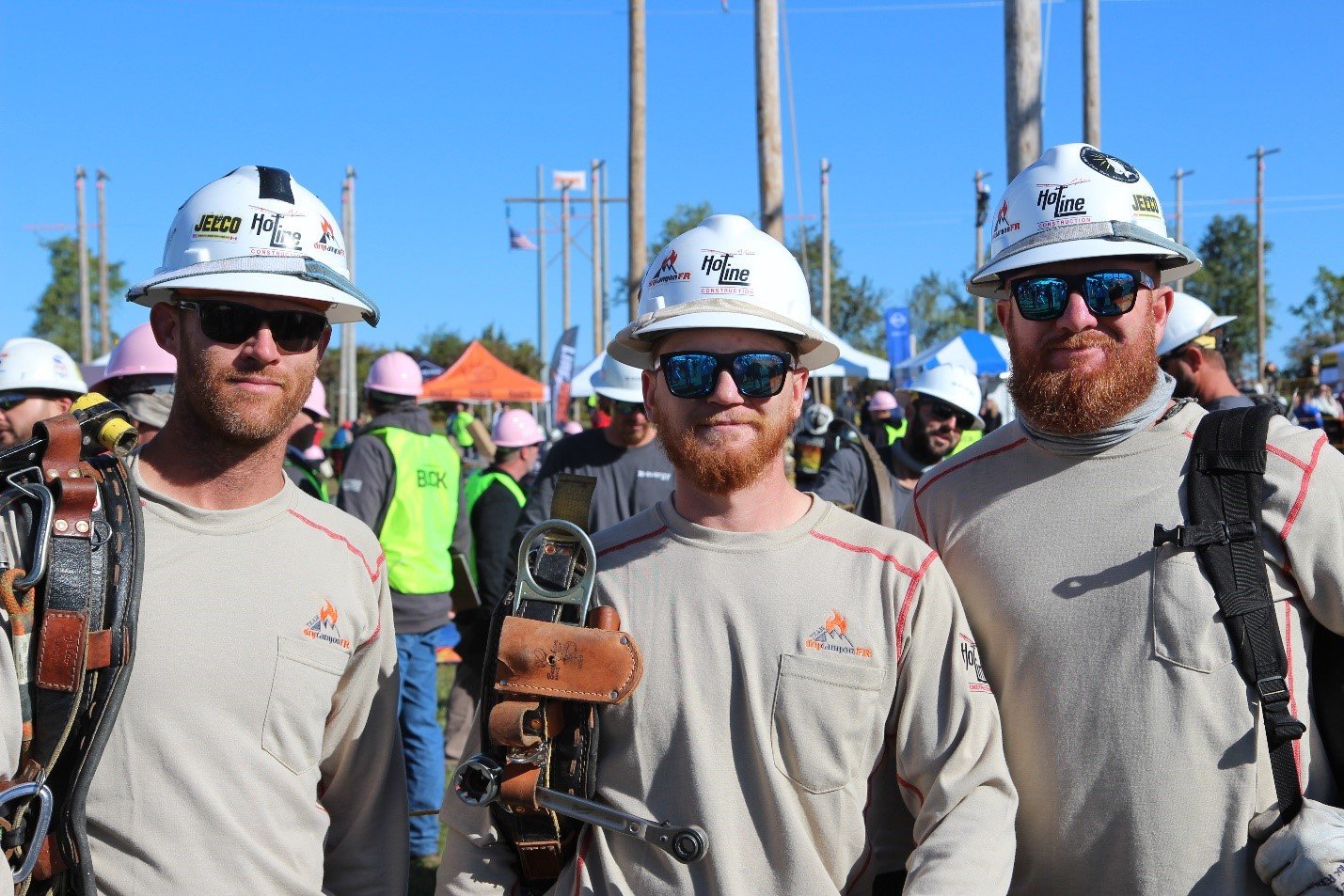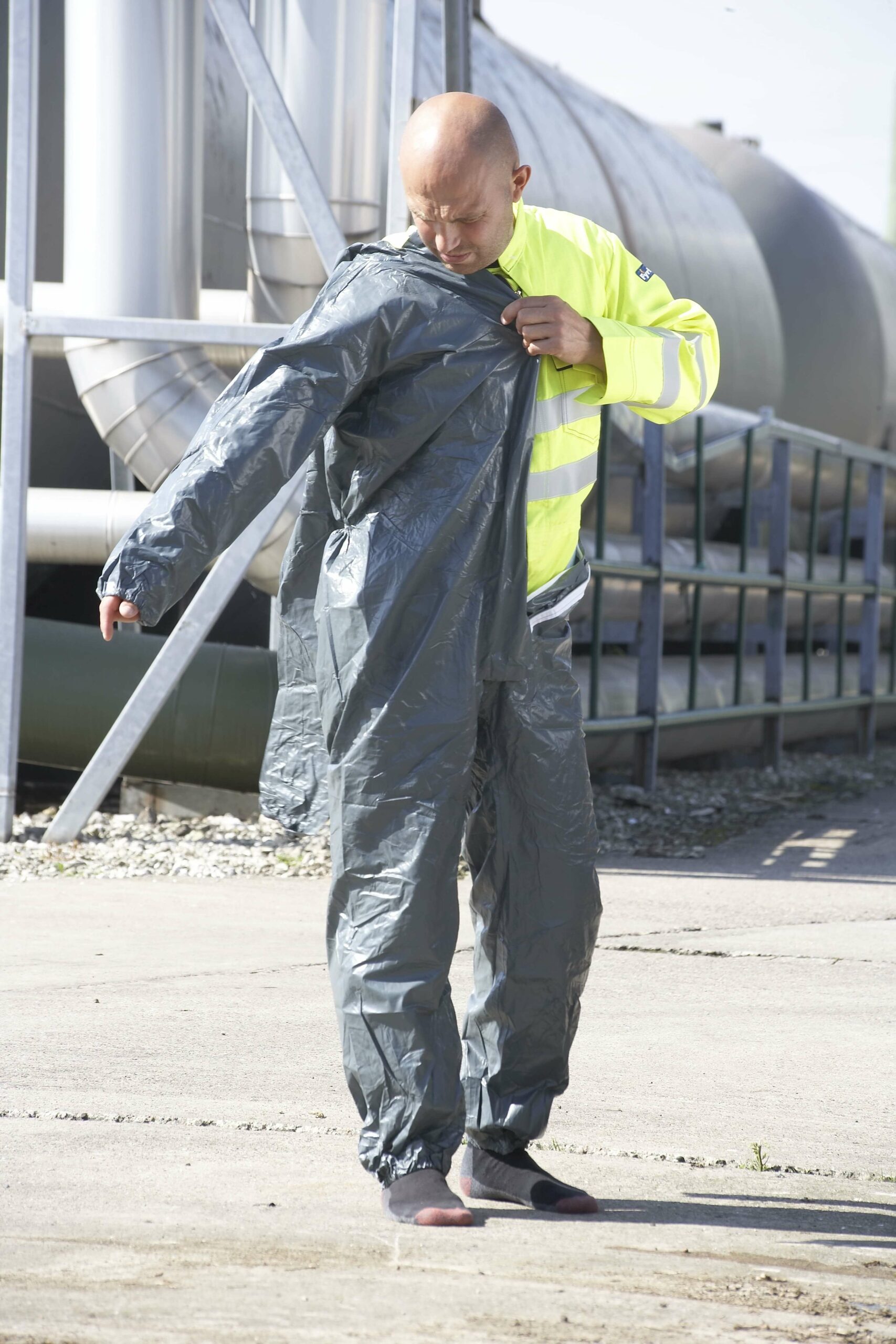Confirming that your FR workwear is certified to the EN 11612 standard is vital. But as always with standards, the devil is in the detail and it is even more important to understand what is in the standard and what it tells you; EN 11612 contains a range of optional tests measuring the fabric’s resistance to transfer of the different types of heat energy with performance levels. This can be useful in ensuring a chosen garment is effective in protecting against the type of heat energy in your application.
However these and others in the standard test only the fabric [LINK to 10 more myths ebook]; only one test – the Thermal Mannequin Test (EN 13506) addresses performance of the whole garment and produces an indication of performance in a simulated real-world flash fire scenario. So this can be extremely useful in understanding how effective your fireproof clothing is – and especially useful in assessing performance of ensembles of garments such as when flame and chemical protection is required concurrently and primary and secondary workwear is worn at the same time. Unfortunately whilst mandatory in North America, in EN 11612 it is optional.
This blog looks at the Thermal Mannequin Test. How it works, how to interpret it and how it is the only testing that proves the difference in performance of different types of primar and secondary FR workwear – even though those different types are certified to the same standard and on the face of it look the same.
What is the Thermal Mannequin Test?
The Thermal Mannequin Test provides vital insight into how effectively a Primary FR garment or a combination of Primary FR and Secondary FR garments will protect the wearer in a flash fire scenario. This is the only test in either the EN 14116 or EN 11612 standard which tests whole garments rather than fabric or components and shows any real indication of whether a garment will actually perform and protect the worker in a real-world scenario.
The test subjects a garment or garment ensemble to a simulated flash fire from four surrounding flame jets, at specific calorific value and normally using a three or four second burn. The “thermal mannequin” on which the garment is worn is covered in 123 heat sensors, each connected to a computer. Each sensor replicates the rate at which human skin absorbs heat energy. Heat energy absorbed may be recorded for 30, 60, 90 or 120 seconds.
What burn duration should be used and for how long should heat energy information be recorded? |
| The EN 11612 standard states that
“…at least 4s at 84kW/M2 gives the most complete information about protective performance of single and multilayer clothing assemblies”. However, whichever is chosen, two points are important:- 1. In order to compare different types of fireproof clothing, it is important to ensure that the kW/M2 level, the burn duration and the time information is recorded are the same. Without this information it is impossible to make judgement or to compare; a test showing a very low incidence of body burn may simply be a reflection of low calorific value, short burn time and short duration of the information recorded. Some manufacturers state a very low body burn from tests, yet fail to detail the test parameters… which makes the body burn information largely meaningless 2. Especially in the case of assessing body burn of primary and secondary FR ensembles, a longer duration of information record – 90 or 120 seconds – is important because the outer material may continue to burn, or the material may have melted and continue to release heat energy, long after the actual burn ceases. A short duration information record would fail to indicate this. |
A well established technique of calculating predicted pain and 1st, 2nd and 3rd degree body burns is used to produce a map showing the probable areas and incidence of pain, 1st, 2nd and 3rd degree burns.
This analysis is known as the “Stoll Curve”, named after Alice Mary Stoll, a biophysicist who established the principle whilst working at the US Naval Development Centre in the 1950’s as part of a project to develop better FR fabrics. This is not to be confused with the curve that measures tolerance of G-forces for pilots, developed by Alice Mary Stoll, whilst working at the US Naval Development Centre in the 1950’s. Also, somewhat confusingly called, the “Stoll Curve”. (no… really..!)
How do you interpret the Thermal Mannequin Test Results for Fire Protective Clothing?
Thus the thermal mannequin test provides an indication of real-world performance and allows effective comparison of how well a garment will protect… the lower the incidence of body burn, the more effective the protection.
In particular as well as showing the extent of burning in terms of a total percentage body burn, it distinguishes between areas of 1st, 2nd and 3rd degree burns. This is vital information because of course whilst 1st and 2nd degree burns are less problematic in that they should heal with treatment, 3rd (and 4th) degree burns are more critical because they are much deeper, destroy tissue and kill nerve endings (counter-intuitively, deeper burns result in little pain because nerves no longer function) and so will not heal and will probably require grafting. If extensive these burns may be life threatening so distinguishing between garments or ensembles that allow 3rd degree burns and those that do not is important.
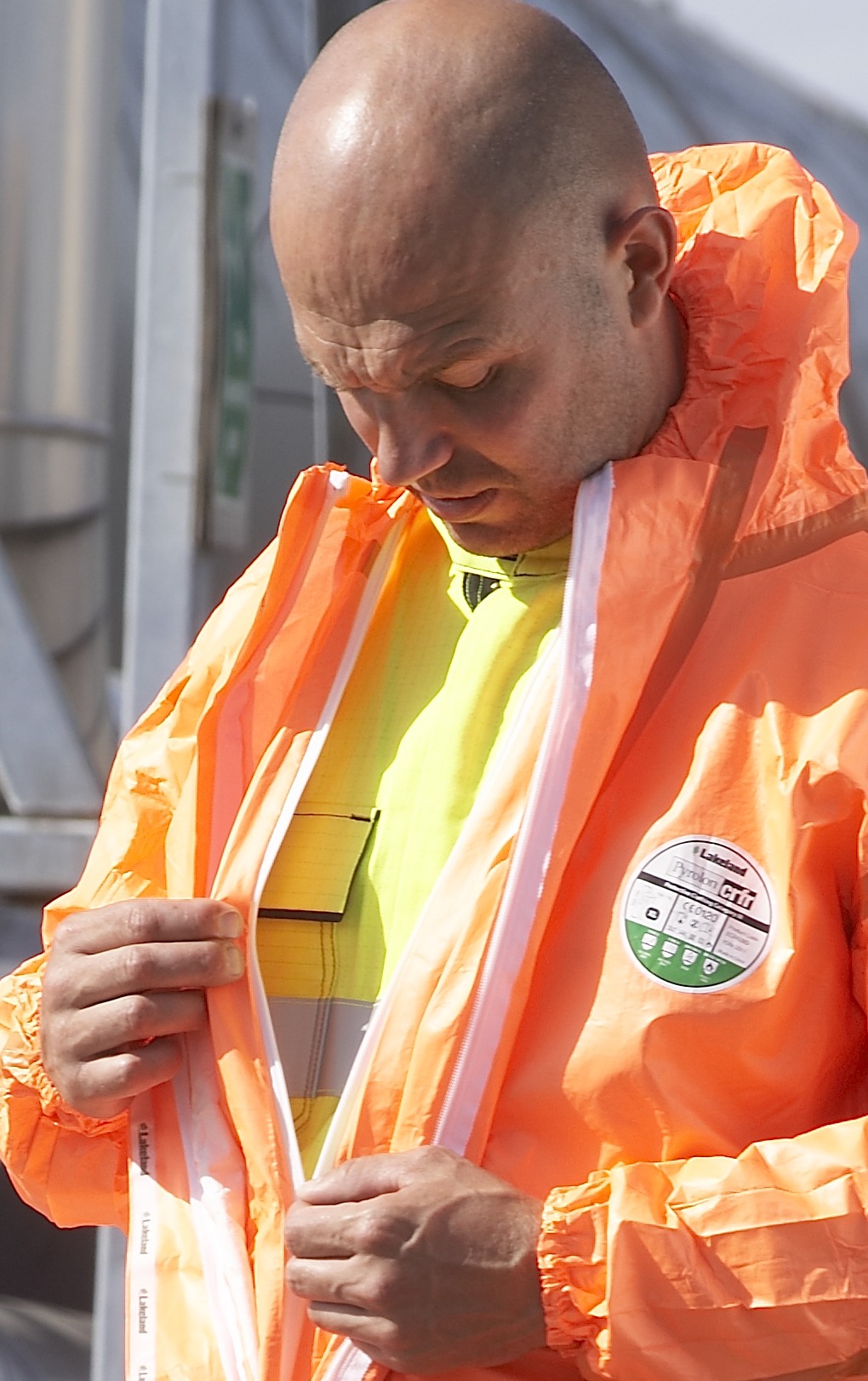
Lakeland, having tested the Pyrolon® range of Secondary FR workwear (including combinations of other types of Secondary FR workwear and standard, plastic-based disposable coveralls), is the only manufacturer of Secondary FR garments that has addressed this issue. The results demonstrate the usefulness of thermal mannequin testing and show major variations in the way different ensembles work in terms of the level of predicted body burn – something not indicated at all by other testing in either EN 14116 or EN 11612. The types of garments tested and results are summarised below.
Thermal Mannequin Testing of various Primary and Secondary Fire Resistant Clothing
1. Standard, non FR, plastic-based coveralls
Few organisations today ask workers to use non-FR, thermoplastic-based coveralls over Primary FR garments, but with this research the risks very clear.
These coveralls are made typically of polypropylene, polyethylene or polymers which will ignite and burn if exposed to heat or flame, transferring heat energy through to the wearer and compromising thermal protection. For this reason, standard plastic-based disposable and chemical clothing cannot be worn over Primary FR workwear. Additional concerns relate to the coverall’s zipper assembly and components: in the event of a fire, the garment may need to be removed quickly, which will be difficult if the zip has burned or melted and does not function as a result.
The Hazards of standard disposable clothing when exposed to heat |
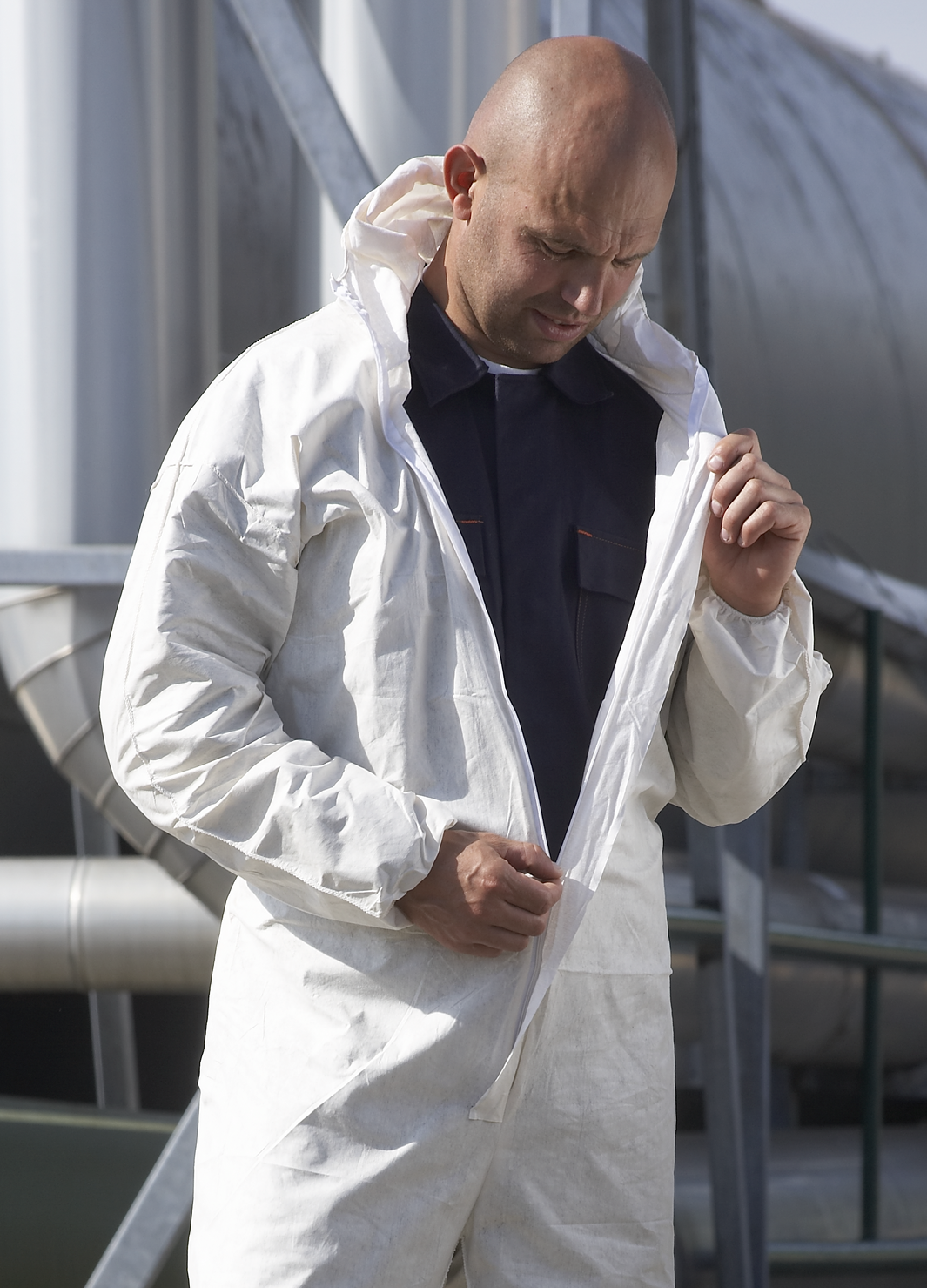 In a recent incident, a worker using a standard, plastic-based disposable chemical suit was splashed with hot liquid. The suit melted and shrank onto the wearer, making it so tight he could not remove it, extending the exposure to the burning liquid and resulting in serious injury. In a recent incident, a worker using a standard, plastic-based disposable chemical suit was splashed with hot liquid. The suit melted and shrank onto the wearer, making it so tight he could not remove it, extending the exposure to the burning liquid and resulting in serious injury.
Pyrolon garments are based on a different fabric technology with superior heat tolerance and higher melt points. With Pyrolon this would not have happened. |
Note: All the tests below were conducted with the same Primary FR workwear and with the same test parameters to ensure the results allow comparison.
COMPARISON 1: A standard, plastic-based disposable coverall worn over Primary FR workwear (below, right) resulted in a major increase in predicted body burn (from 37% to 53%) compared to the Primary FR workwear worn alone (below left). It also added more critical 3rd degree burns.
VERDICT:
VERDICT: A standard plastic-based coverall worn over Primary FR workwear risks destroying thermal protection, dramatically increasing body burn, perhaps critically, and should NEVER be worn over primary FR Workwear.
2. Plastic-based/FR treated Secondary FR Workwear
Not all certified Secondary FR workwear is the same; some types will perform effectively whilst others poorly in real-world situations. While meeting the requirements of EN 14116, some cheaper types are made of standard, plastic-based fabrics with a chemical FR treatment applied. Unfortunately, testing in EN 14116 fails to differentiate between them. Only Thermal Mannequin Testing highlights the difference.
COMPARISON 2: A plastic based FR, EN 14116 garment (worn over the primary FR workwear) shows a body burn of 19.6% (bottom right). A standard NON FR plastic-based coverall shows a body burn of 20.5% (below left). Both present 2nd and more critical 3rd degree burns.
VERDICT: Testing has indicated that the difference in predicted body burn between a standard, plastic-based coverall and the same plastic-based coverall with an FR treatment is less than 1% – despite the latter being certified to EN 14116. The conclusion is that simple certification to EN 14116 is no indicator of effective performance of Secondary FR workwear and that FR treated polypropylene disposable garments, whilst more expensive, show very little difference in performance form non-FR disposables
3. Pyrolon® Secondary FR Workwear
Lakeland’s Pyrolon® suits use a viscose-based fabric, developed specifically for its FR properties. This fabric does not ignite and does not burn, thus allowing it to be worn over primary FR workwear for chemical protection without destroying the thermal protection.
COMPARISON 3: Pyrolon® Plus 2 and Pyrolon® XT (both Type 5 & 6 chemical protection and certified to EN 14116) are tested over the same primary FR workwear and with the same test conditions. Both show dramatically lower predicted body burn (7.4% and 8.2%) – less than half of the plastic based coveralls tested above. Neither show any 3rd degree burns.
VERDICT: Thermal Mannequin Testing of Pyrolon® garments worn over Primary FR workwear has proven its effectiveness in not compromising thermal protection – indeed, predicted body burn is lower with Pyrolon® than wearing the primary thermal protective garment on its own. This is because Pyrolon® is made from a unique viscose-based material, specifically engineered for FR properties and will not ignite and burn.
TEST CONCLUSIONSThermal Mannequin Testing has shown that :- 1. Wearing standard, plastic-based workwear over primary FR workwear results in an increase in predicted body burn. Standard disposable clothing should NEVER be worn over primary FR workwear 2. There is little difference in performance between standard, non-FR coveralls and plastic-based, polypropylene FR-treated coveralls (even though they are certified to EN 14116). The predicted body burn difference is less than 1%. These more expensive FR coveralls offer almost no improvement in performance over their non-FR versions. 3. Wearing Pyrolon® Secondary FR workwear results in a substantial reduction in predicted body burn less than half the results for the other garments. They also show no 3rd degere burns. Thermal mannequin testing shows they offer far more effective performance than any non-specialist secondary FR workwear certified to EN 14116. The graph below summarises the results and shows that only Pyrolon® is proven to work effectively when Secondary FR workwear is required. |
You can also watch the burn performance comparison video to see how different fabrics perform in a vertical flammability test as required by EN 14116:
CONCLUSIONS:
The importance of Thermal Mannequin Testing in assessment of Fire Protective Clothing
The example of testing different types of Secondary FR workwear is a prime indication of the usefulness of thermal mannequin testing in assessment of fire protective clothing performance and how an understanding how to interpret the test results can be a vital addition to the Safety Managers’ tool box – and how misunderstanding or misinterpreting can result in a failure to ensure workers are properly protected.

